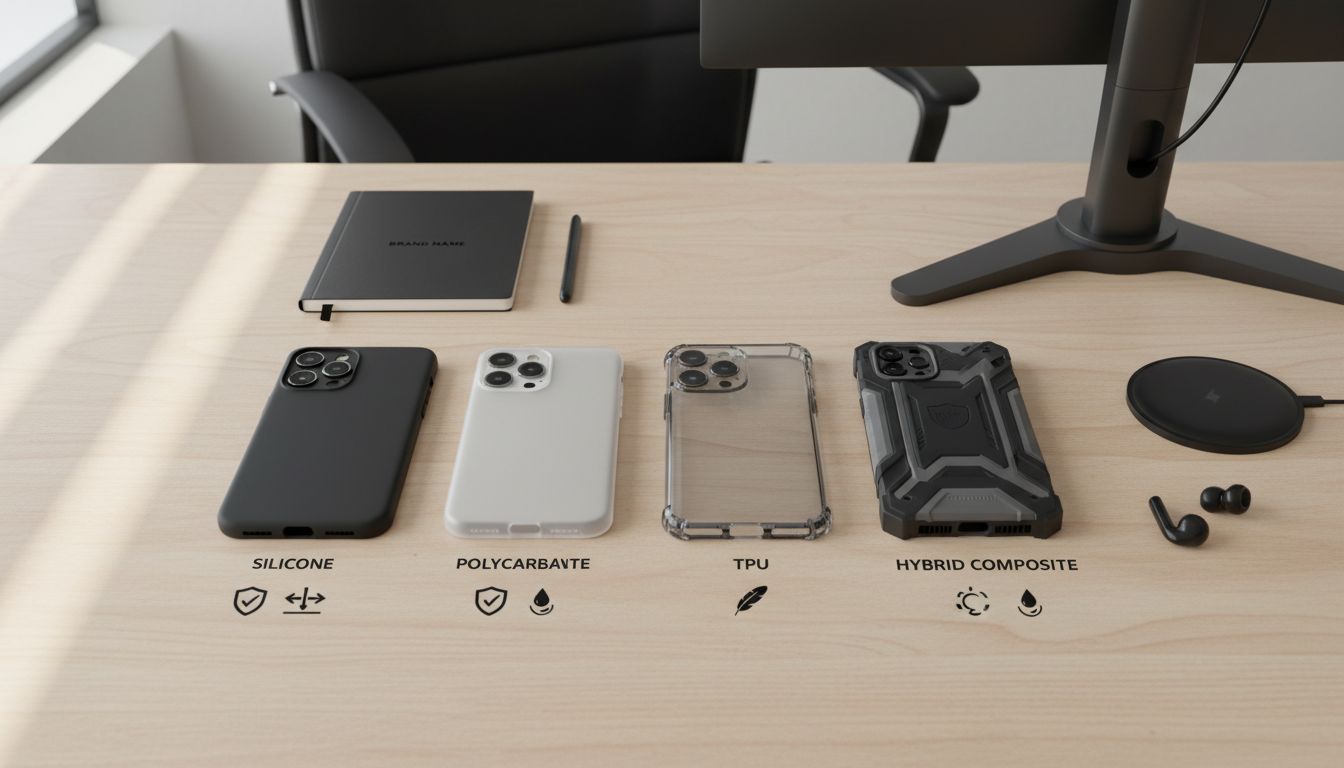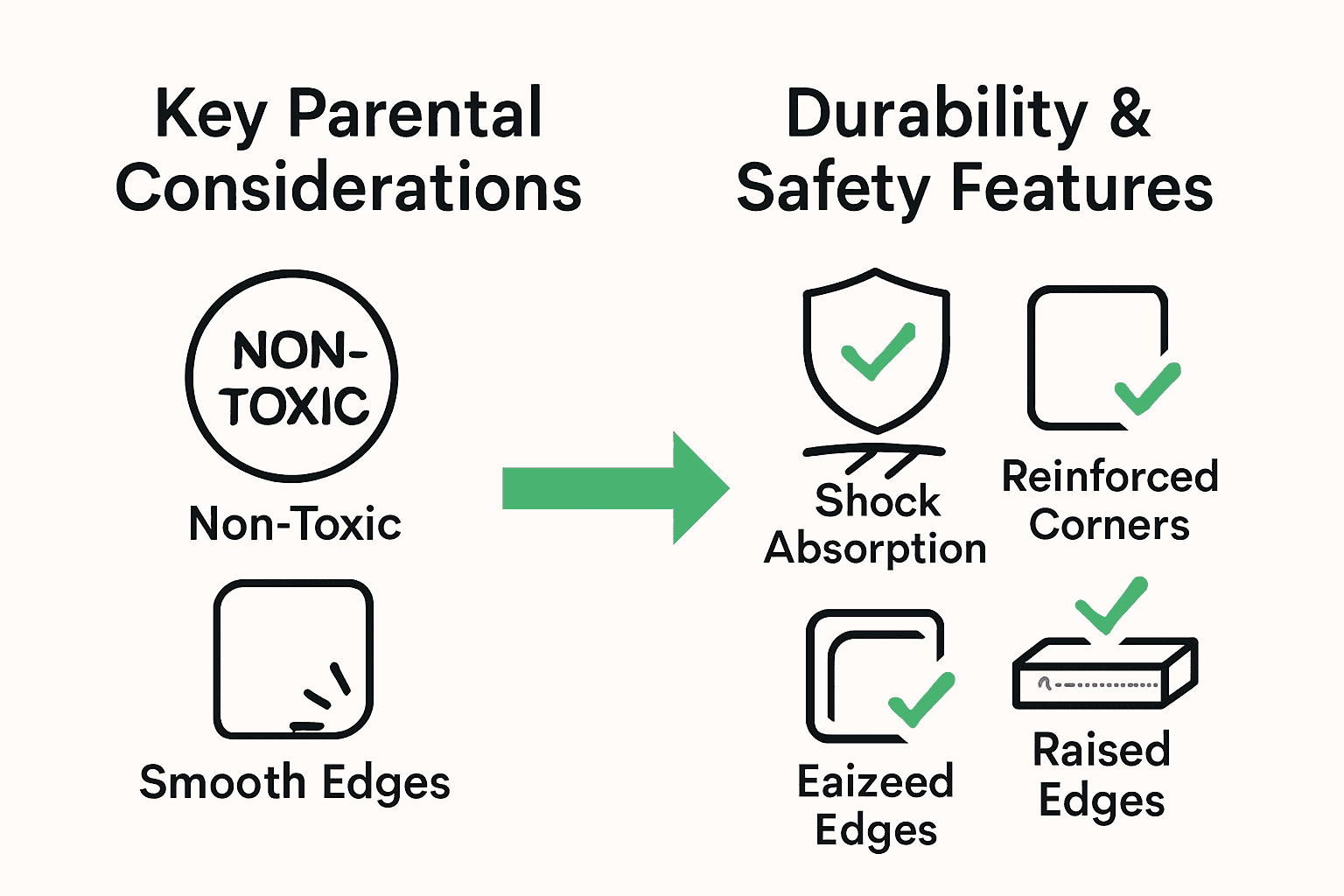
Phone Case Durability: Essential Guide for UK Users
Share
Nearly 90 percent of smartphone users have experienced a cracked screen or damaged device at some point, making phone case durability more than just a marketing promise. Your mobile is at risk from drops, scratches, moisture, and extreme temperatures every day. Understanding the core principles behind phone case durability gives you the power to choose protection that actually works and stands up to real-life wear.
Table of Contents
- Defining Phone Case Durability Principles
- Common Case Materials And Their Strengths
- Durability Testing And Impact Resistance Standards
- Practical Implications For UK Parents
- Maintaining Durability Through Everyday Wear
Key Takeaways
| Point | Details |
|---|---|
| Durability Principles | Phone case durability includes material strength, impact resistance, and protection against environmental conditions to safeguard devices effectively. |
| Material Selection | Common materials like silicone, polycarbonate, and TPU offer unique strengths; choosing the right material is crucial for effective protection. |
| Testing Standards | Compliance with rigorous testing standards such as Kitemark certification ensures reliability and performance in real-world scenarios. |
| Parental Considerations | Parents should prioritize child-friendly materials and enhanced protection features to ensure safety and durability for children’s devices. |
Defining Phone Case Durability Principles
Phone case durability isn’t just about how tough a case looks. It’s a comprehensive concept encompassing multiple protective attributes that safeguard your valuable mobile device against everyday wear and potential damage. According to the British Standards Institution, product durability involves meeting specific quality standards that ensure long-term performance and protection.
The core principles of phone case durability revolve around several key factors. These include material strength, impact resistance, scratch protection, and resilience against environmental conditions. A truly durable phone case must withstand drops, resist scratches, maintain structural integrity, and protect against moisture and temperature variations. While the General Product Safety Regulations 2005 mandate that consumer products must be safe, phone case manufacturers take this requirement seriously by designing cases that provide comprehensive device protection.
When evaluating phone case durability, consumers should consider these critical aspects:
- Material Quality: High-grade polymers, silicone, and reinforced composites
- Drop Protection: Ability to absorb shock from falls and impacts
- Edge and Corner Reinforcement: Extra protection for device’s most vulnerable areas
- Water and Dust Resistance: Sealed edges and protective membranes
To gain deeper insights into selecting the most durable phone cases, check out our guide on selecting durable phone cases for long-lasting protection. Understanding these durability principles will help you make an informed decision that keeps your mobile device safe and sound.
Common Case Materials And Their Strengths
Phone case materials are not created equal. Each material brings unique protective characteristics that determine how effectively your device remains safeguarded against daily wear and potential damage. British Standards provide comprehensive guidelines on evaluating material properties, ensuring consumers understand the performance potential of different case materials.
The most common phone case materials include silicone, polycarbonate, TPU (thermoplastic polyurethane), and hybrid composites. Silicone offers excellent shock absorption and flexibility, while polycarbonate provides rigid structural protection. TPU combines the best of both worlds with its rubber-like elasticity and strong impact resistance. Interestingly, research from Nottingham Trent University on modular device design highlights how material selection can significantly extend a product’s functional lifespan.
Let’s break down the strengths of each material:
-
Silicone:
- Excellent grip
- Superior shock absorption
- Lightweight and flexible
-
Polycarbonate:
- Rigid protection
- High scratch resistance
- Slim profile
-
TPU:
- Combines flexibility and strength
- Excellent impact resistance
- Good thermal stability
-
Hybrid Composites:
- Multilayered protection
- Enhanced drop protection
- Customizable design options
To learn more about selecting the right phone case material for your specific needs, explore our guide to phone case materials. Your choice of material can make a substantial difference in protecting your valuable mobile device.

Durability Testing And Impact Resistance Standards
Understanding how phone cases are tested for durability is crucial for consumers seeking reliable device protection. Kitemark certification represents the gold standard in product quality assessment, involving rigorous testing procedures that evaluate a phone case’s ability to withstand real-world challenges.
British Standards outline comprehensive testing methods that simulate various potential damage scenarios. These standards assess critical performance metrics including drop resistance, impact absorption, material integrity, and structural resilience. Manufacturers typically subject phone cases to multiple standardized tests that replicate everyday wear and extreme conditions, such as multiple consecutive drop tests from different heights, temperature variations, and mechanical stress evaluations.
Key durability testing protocols typically include:
-
Drop Test:
- Multiple drops from standardized heights
- Simulates accidental falls onto hard surfaces
- Measures structural integrity after impact
-
Scratch Resistance Test:
- Uses precision abrasion tools
- Evaluates surface durability
- Determines material’s resistance to daily wear
-
Compression Test:
- Measures material’s ability to absorb and distribute shock
- Assesses long-term structural performance
- Determines potential protection levels
-
Temperature Resilience Test:
- Exposes case to extreme temperature ranges
- Checks material stability and performance
- Ensures consistent protection in varied environments
For more detailed insights into selecting a robust phone case, explore our 7 durable phone case features every parent should know. Understanding these testing standards helps you make an informed decision about protecting your valuable mobile device.
Practical Implications For UK Parents
Navigating phone case selection becomes critically important for parents managing children’s mobile devices. General Product Safety Regulations 2005 establish clear guidelines ensuring that consumer products, including phone cases, meet stringent safety standards designed to protect vulnerable users like children.
Parents face unique challenges when selecting phone cases that balance protection, durability, and child-friendly design. Impact resistance and material safety emerge as paramount considerations. Kitemark certification provides an additional layer of confidence, indicating that a phone case has undergone independent testing to verify its protective capabilities and meet rigorous safety benchmarks.
Key practical considerations for UK parents include:
-
Child-Friendly Materials:
- Non-toxic substances
- Smooth, rounded edges
- Hypoallergenic construction
-
Enhanced Protection Features:
- Shock-absorbing designs
- Raised screen edges
- Reinforced corner protection
-
Durability Factors:
- Resistance to drops
- Ability to withstand daily child handling
- Long-lasting performance
-
Additional Safety Considerations:
- Easy grip surfaces
- Minimal small detachable parts
- Compatible with child-friendly screen protectors
For comprehensive insights tailored to UK parents, explore our mobile accessories guide for busy parents. Understanding these practical implications helps parents make informed decisions about protecting their children’s valuable mobile devices.

Maintaining Durability Through Everyday Wear
Phone cases endure a relentless bombardment of daily challenges that can gradually compromise their protective capabilities. Insights from Nottingham Trent University’s research on device modularity highlight the importance of proactive maintenance in extending a case’s functional lifespan.
British Standards outline comprehensive guidelines for maintaining product durability, which are particularly relevant to phone case longevity. Preventative care becomes crucial in mitigating wear and tear, with users playing a direct role in preserving their case’s protective integrity. Regular maintenance can significantly extend a phone case’s effectiveness, protecting your valuable device from potential damage.
Key strategies for maintaining phone case durability include:
-
Cleaning Techniques:
- Use soft, lint-free cloths
- Avoid harsh chemical cleaners
- Gently remove dirt and debris regularly
-
Impact Prevention:
- Avoid dropping the phone
- Use additional screen protectors
- Be mindful of extreme temperatures
-
Storage Practices:
- Store in cool, dry environments
- Avoid direct sunlight
- Keep away from sharp objects
-
Periodic Inspection:
- Check for small cracks or wear
- Replace case if structural integrity is compromised
- Monitor edge and corner protection
To dive deeper into protecting your mobile device, check out our comprehensive phone case protection guide for UK users. Proactive maintenance is your first line of defense in preserving your phone case’s protective capabilities.
Protect Your Device with Durable Phone Cases from StudioShake
Choosing the right phone case means safeguarding your device against drops, scratches, and daily wear. As highlighted in our guide, durability is essential for long-lasting protection, especially with materials and features designed to absorb impact and resist damage. If you want peace of mind knowing your phone is shielded by trusted quality and tested standards, it is time to explore options tailored for ultimate protection.

Discover our specially curated £1 Case Collection – StudioShake for affordable durability without compromise. For Apple users, our extensive iPhone – StudioShake range combines style with strong impact resistance. Browse our Our Bestsellers – StudioShake to find customer favourites designed with protection and resilience in mind. Protect your device today by visiting StudioShake and choose the durable case that matches your lifestyle.
Frequently Asked Questions
What factors determine the durability of a phone case?
The durability of a phone case is determined by material strength, impact resistance, scratch protection, and resilience against environmental conditions. High-quality materials and design features enhance the protective capabilities of a phone case.
What materials are commonly used in phone cases and their strengths?
Common phone case materials include silicone, polycarbonate, TPU (thermoplastic polyurethane), and hybrid composites. Silicone offers shock absorption, polycarbonate provides rigidity, TPU combines flexibility and strength, while hybrid composites offer multilayered protection.
How are phone cases tested for durability?
Phone cases are tested for durability through a variety of protocols, including drop tests, scratch resistance tests, compression tests, and temperature resilience tests. These tests evaluate their ability to withstand everyday wear and extreme conditions.
What maintenance tips can help extend the lifespan of a phone case?
To extend the lifespan of a phone case, regularly clean it with soft, lint-free cloths, avoid dropping the phone, store it in cool environments, and periodically inspect for wear and damage to ensure timely replacements.
